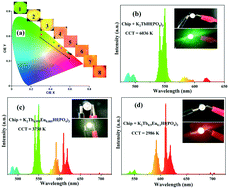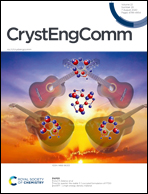Energy transfer, multi-colour emission and high thermal stability behaviour of K2Tb1−xEuxHf(PO4)3 with langbeinite-type structure†
Abstract
Eu3+/Tb3+ codoped phosphors usually present multi-color emitting performances ranging from green and yellow to red, which not only have theoretical but also practical significance. In this work, we prepared a new langbeinite-type compound, K2TbHf(PO4)3, determined its structure via single-crystal X-ray diffraction, and prepared solid solutions of K2Tb1−xEuxHf(PO4)3 (x = 0–1) with multi-color emitting properties. The structure of the solid solutions was refined by the Rietveld method, showing a constant lattice structure with a change in Eu3+ concentration from 0 to 100%. For the typical sample, K2Tb0.99Eu0.01Hf(PO4)3, both Tb3+ and Eu3+ emission peaks were observed upon excitation by near ultraviolet light of 378 nm, whereas only the characteristic peaks of Eu3+ were observed when the excitation source was 393 nm. This suggests that the energy transfer from Tb3+ to Eu3+ occurred, but not the reverse transfer. The emitting color of K2Tb1−xEuxHf(PO4)3 could change from green and yellow to red by simply modulating the concentration of Eu3+. Meanwhile, the temperature-dependent analysis proved the high thermal stability of the prepared phosphor. Finally, green, yellow, and red near-ultraviolet pumped LEDs were fabricated using three typical phosphors with x = 0, 0.005, and 0.10, respectively.



 Please wait while we load your content...
Please wait while we load your content...